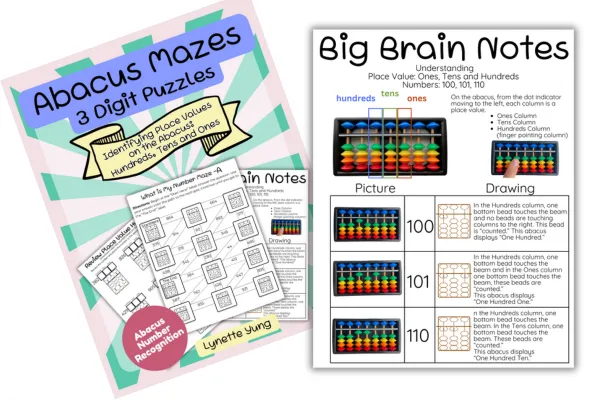
Abacus Mazes - 3 Digit Puzzles
Abacus Mazes - 3 Digit Puzzles
What is an abacus maze?
An abacus maze is a puzzle where the goal is to navigate a path from a "Start Here!" label to a "The End!" label by correctly identifying the number represented by the abacus in each box and following the path indicated by that number. The mazes in this book use 3-digit numbers.
How do I read an abacus in this book?
The abacus in this book has a horizontal bar, called the beam or reckoning bar. The beads above the beam each have a value of 5, and the beads below the beam each have a value of 1. When a bead is touching the beam, its value is counted. To read the number represented by the abacus in each column, you count the value of the beads touching the beam in that column.
What are the place values represented on the abacus in this book?
The abacus in this book represents the ones, tens, and hundreds place values. The column on the right is the ones column, the column to its left is the tens column, and the leftmost column shown is the hundreds column. Dots on the abacus can help indicate the place values, similar to commas or periods in written numbers.
How do I determine the number shown on the abacus for single digits (0-9)?
For single digits, you look at the beads in the ones column. Zero is represented by no beads touching the beam. Numbers 1 through 4 are represented by the corresponding number of bottom beads touching the beam. Five is represented by the top bead touching the beam. Numbers 6 through 9 are represented by the top bead and the corresponding number of bottom beads touching the beam.
How do I determine the number shown on the abacus for two-digit numbers (10-99)?
For two-digit numbers, you look at both the tens and the ones columns. The tens column functions similarly to the ones column but represents groups of ten. For example, ten is represented by one bottom bead touching the beam in the tens column and no beads touching the beam in the ones column. Eleven is one bottom bead in the tens column and one bottom bead in the ones column. Twelve is one bottom bead in the tens column and two bottom beads in the ones column, and so on.
How do I determine the number shown on the abacus for three-digit numbers (100-999)?
For three-digit numbers, you look at the hundreds, tens, and ones columns. The hundreds column works like the tens and ones columns but represents groups of one hundred. One hundred is represented by one bottom bead touching the beam in the hundreds column and no beads touching the beam in the tens and ones columns. One hundred one is one bottom bead in the hundreds and ones columns, and no beads in the tens column. One hundred ten is one bottom bead in the hundreds and tens columns, and no beads in the ones column.
How do I solve the "What is My Number Maze"?
To solve the "What is My Number Maze," you start at the square labeled "Start Here!". Read the abacus in that square to determine the starting number. Then, find the number in the adjacent squares that matches the number you just read from the abacus. Color the path from the "Start Here!" box to that square. Repeat this process, reading the abacus in the new square and following the path indicated by that number, until you reach the square labeled "The End!".
What are "Reverse Mazes"?
"Reverse Mazes" provide the path but not the abacus representation for some steps. In these mazes, you are given a numbered path, and your task is to color the counted beads on the abacus in each box to represent the number shown on the path connecting to it. This helps reinforce the understanding of how numbers are represented on the abacus.
Here is a podcast episode Deep Diving into 3 Digit Abacus Maze.

